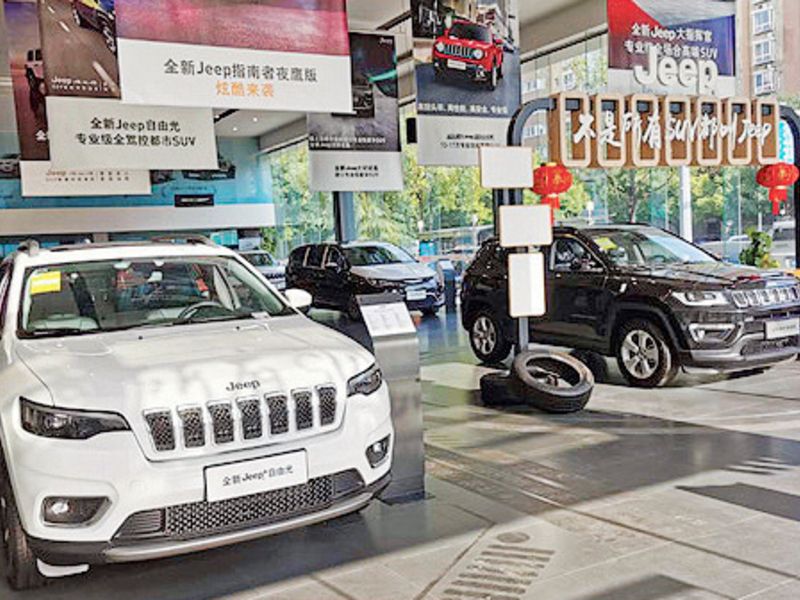
SHANGHAI — With the coronavirus outbreak largely contained since March in China, the local market for new passenger vehicles and light trucks has sustained growth for five straight months.
But there has been little to celebrate for American brands here. Except for Tesla, demand for U.S.-brand vehicles remains subdued, leaving many of their dealers struggling in the red.
The worst performer among them is Jeep. While China’s overall market has returned to growth mode, Jeep sales are stuck in a downward spiral that began in 2018.
FCA Group now produces vehicles for only the Jeep brand in China. It assembles the gasoline and plug-in hybrid variants of the Grand Commander as well as the gasoline models of the Renegade, Compass and Cherokee at its joint venture with GAC Motor Co.
In September, Jeep sales fell 36 percent from a year earlier to 3,862, with year-to-date volume plummeting 47 percent to 27,675, according to GAC.
That’s in stark contrast to the performance of the overall market. New light-vehicle sales across China rose 8 percent last month, with the decline for the pandemic-fraught first nine months of this year narrowed to 12 percent.
Jeep’s troubles date back to 2015, when FCA launched local production but failed to keep product quality under control, according to John Zeng, Asia director of LMC Automotive in Shanghai.
Local production allowed FCA to sell Jeep models at much lower prices than imports, which were subject to a hefty 25 percent tariff in China. As a result, Jeep demand started to take off.
In 2017, Jeep sales exceeded 200,000, more than doubling the volume in 2014.
“As Jeep’s sales surged, customer complaints multiplied about its product quality problems,” Zeng said.
In September 2018, a group of Jeep owners complained on state-run China Central Television about the problems of excessive engine oil burning and sudden loss of power with models such as the new Cherokee and Compass.
Additional reports surfaced in Chinese press and social media about problems ranging from abnormal noises with transmissions to poor quality of exterior components, such as windshields and sunroofs.
“All these problems have hurt Jeep’s brand image as well as its sales,” Zeng said.
For 2018, Jeep sales shrank to below 130,000. In August of that year, 35 Jeep store owners from all over China gathered at FCA’s China sales company in Shanghai, demanding compensation for their losses.
At the Beijing auto show last month, executives from FCA-GAC provided an update for Chinese media on Jeep’s electrification and vehicle connectivity plans, without mentioning measures to address lingering customer grievances about product quality.
Meanwhile, sales of General Motors’ and Ford Motor Co.’s proprietary brands in China have recovered but in an unimpressive way.
In September, sales at SAIC-GM, GM’s joint venture with SAIC Motor Corp. producing and marketing Cadillac, Buick and Chevrolet vehicles, rose 9.6 percent to top 153,000, according to SAIC.
Because the sales recovery didn’t materialize until July, SAIC-GM’s deliveries through September show a slump of 22 percent, falling just short of 952,000.
The rebound came at a price.
To boost sales in the wake of the coronavirus outbreak, many global brands lowered vehicle prices by an average of 20,000 yuan ($2,990), the China Automobile Dealers Association said in a report this month.
The steepest price cuts, averaging 30,000 yuan, came from the GM brands. Buick’s Envision S, the upgraded version of the Envision crossover, went on sale in China in July at a starting price of 219,900 yuan. But at a Buick dealership in southwest Shanghai last week, the vehicle was selling for 40,000 yuan less, a discount equal to almost $6,000 on the new model.
U.S.-make dealerships here were already suffering from red ink. Just 11 percent of Jeep dealerships were profitable in 2019, according to a research report released by Detroit-based consultancy Urban Science along with Lechebang, a Shanghai company providing management advisory and IT services for dealerships in China. It found that only 30 percent of Chevrolet dealers made a profit in 2019, as did 36 percent of Buick dealers.
Ford is not out of the woods, either.
Ford’s China deliveries plunged for the three years following its 2016 results of 1.08 million sales, due partly to a lack of fresh products. This year, Ford sales have staged a strong rebound. But the volume is still reduced — reaching around 232,000, according to numbers disclosed by Ford’s two joint venture partners, Changan Automobile Co. and Jiangling Motors Corp.
Changan Ford is the U.S. company’s main partner in China, building and distributing sedans and crossovers for the market. According to the report from Urban Science and Lechebang, only 23 percent of Changan Ford’s 600-plus dealerships made money last year.